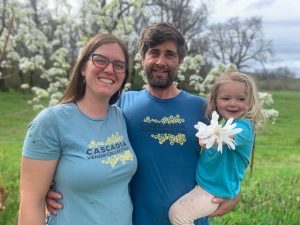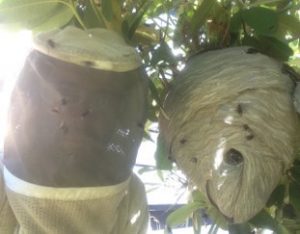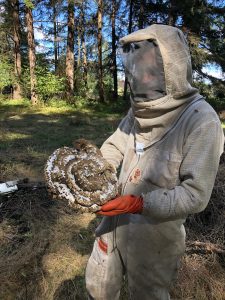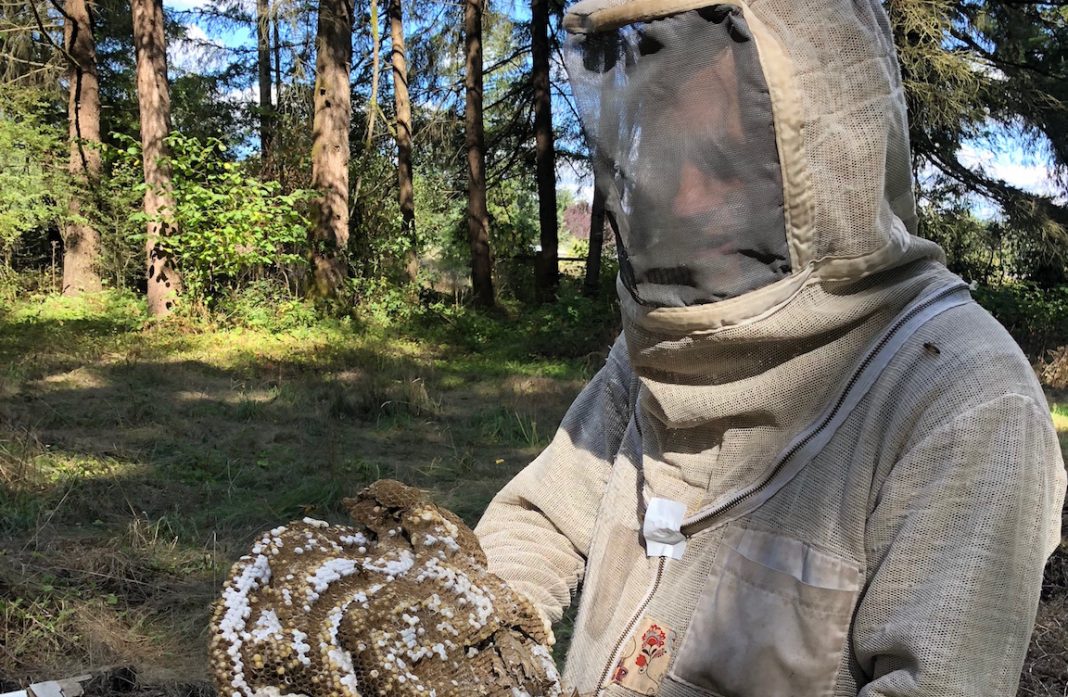I love to eat outside. I don’t like yellowjackets. You’ll be having a bite to eat out on your deck and minding your own business. Then out of nowhere a wasp swoops in. She is aggressively interested in your food. A flick of the wrist might move her back a foot, but she returns in a moment. Waving flyswatters and yelling does no good. Then a wasp buddy shows up and it’s time to go back inside. I’m an ardent nature lover and will gladly take a live spider outside. But I don’t like wasps. Now I have a solution. Contact Cascadia Venom Collection.

Owners Zach and Stephanie Techner and their capable team can come out to your home or business and remove the nest along with its offending residents. The miraculous part of this story is that Cascadia Venom Collection removes the nest for free and without any chemicals! The wasps are collected with a vacuum and special trap and then immediately frozen with dry ice. Later they are cleaned and sorted. The males are without stingers so they are discarded. The queens and workers are shipped to labs that extract their venom and make allergy testing products and immunotherapy medication for folks who experience life threatening reactions to their stings. For this reason, they only collect unsprayed nests.
Early this spring you may have spotted a large queen zooming around. The fertilized queen emerged from hibernation where she had been tucked away in a snug place such as your wood stack, a hollow log, or under the bark of a tree. Upon waking she begins to feed on nectar and look for an appropriate site to establish her annual colony. Once she chooses a nesting site, she begins building her nest and lays her first round of eggs. After the first workers are born, they immediately get busy gathering food and nesting material in order to increase the size of their colony. The population then grows exponentially.
Cascadia Venom Collection begins their season in June by collecting yellow hornets, also known as aerial yellowjackets. They build nests that look like large paper balls with a single hole at the bottom. They are most often found under eaves and sometimes in birdhouses. The collectors wear special handmade suits, boots, gloves, and safety glasses. Some of these insects can actually spray venom. After the initial swarm is sucked up, Cascadia Venom Collection stays on site for up to an hour to collect the wasps that were out foraging as they return.

In August and September, large black and white bald-faced hornets become a main target species. They also make large paper ball nests and are extremely defensive in protecting their colonies. At this point in the season, yellowjackets also start becoming a big problem. Sometimes yellowjackets nest in wall cavities or underground. Don’t worry, even if a nest is concealed, Cascadia Venom Collection can do an extraction.
In 2005, Zach started working collecting nests for Bee Man Exterminators. He was in college and found the work challenging and exhilarating. Through college Zach studied agriculture, biology and evolutionary biology. He eventually bought the business in 2017. “It the best business ever,” shares Zach. And that’s true. A qualified person comes to your home, and a nasty source of irritation and something that is literally dangerous is removed without the use of any chemicals, and free of charge. Finally, the collected wasps go on to make life saving products. You get to go back outside for a peaceful meal again. That’s amazing.
Cascadia Venom Collection does not collect bumblebees, which can be identified by their large, round fuzzy bodies and slower movement. There are eight species in our area with abdomen colors ranging from orange to yellow to black. They live in and around mouse burrows, crawl spaces and birdhouses. Although they have the ability to sting, they are generally non-aggressive, even when their nest site gets disturbed. They are extremely valuable native pollinators and have a relatively short annual life cycle. If you find a bumblebee nest, give them some space and enjoy them for the brief time they are around.

The ubiquitous polistes wasps have long dangly legs and build those small, flat paper nests with an exposed honeycomb like structure on the bottom. They are extremely common and found under most eaves. Cascadia Venom Collection does collect this non-native species, but only when they are already at a site to remove a hornet or yellowjacket colony.
Bees and yellowjackets have similarities but are pretty easy to identify once you know their differences. They both can sting, but more often honeybees attack when provoked while hornets and yellowjackets are naturally more aggressive predators. Honeybees have hairy bodies and legs, where wasps have smooth bodies. The abdomen and thorax of a bee is round and a wasp is more cylindrical. We want to protect the bees as they pollinate our food. There are also a number of solitary species of wasps and bees in our area. None of them are aggressive, and all are considered valuable native insects.
To identify the insect that may be aggravating you, go to Cascadia Venom Collection’s website. The summer brings different insects at different times. You can request a removal through their website or by calling 360-866-1834. In the full swing of summer, Cascadia Venom Collection receives upwards of 150 calls per day, but you will be served promptly.
If you hold a soft spot for yellowjackets it is worthy to note that at the end of the summer all but the fertilized queens will perish. It’s wonderful that pesky hornets and yellowjackets can be put to a higher and better use – making allergy medicine. Cascadia Venom Collection serves all of Thurston County and parts of Lewis, Mason, Pierce, and Grays Harbor Counties. For more information and updates throughout the season, visit the Cascadia Venom Collection website.
Sponsored

















































